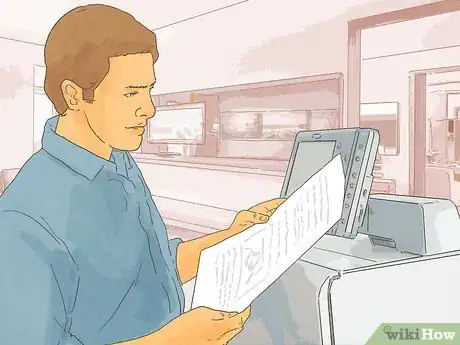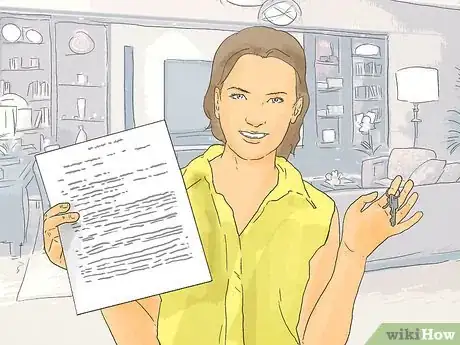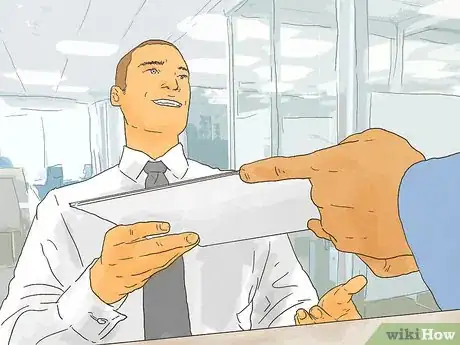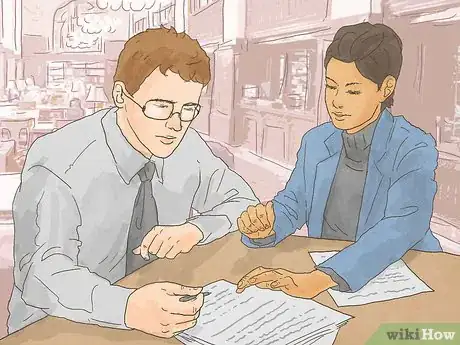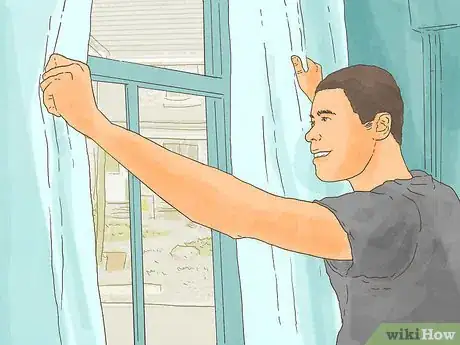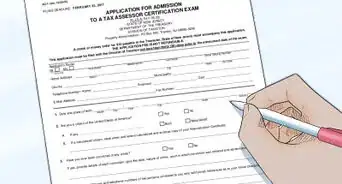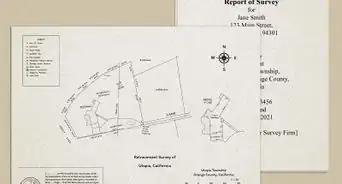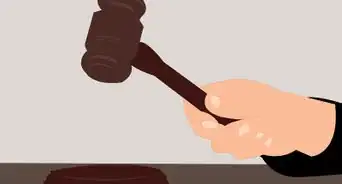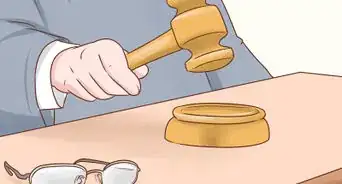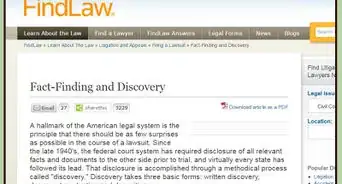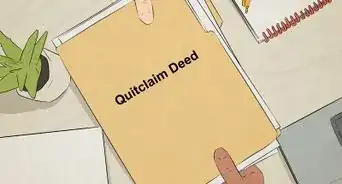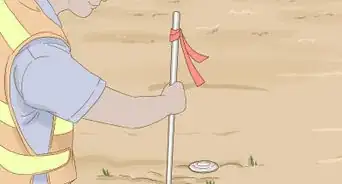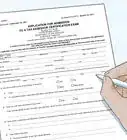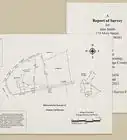This article was written by Jennifer Mueller, JD. Jennifer Mueller is an in-house legal expert at wikiHow. Jennifer reviews, fact-checks, and evaluates wikiHow's legal content to ensure thoroughness and accuracy. She received her JD from Indiana University Maurer School of Law in 2006.
There are 7 references cited in this article, which can be found at the bottom of the page.
This article has been viewed 244,603 times.
In the simplest case, you prove ownership of a house with a registered deed to the property that has your name on it. However, this simple method isn't always available. If property has been in your family for generations, documents may not be available.[1] In an area devastated by a natural disaster, documents may have been destroyed. In these situations, you may have to take extra steps to prove ownership of a house. If you're seeking disaster relief, you may need to prove occupancy in addition to (or instead of) proving ownership.
Things You Should Know
- The easiest way to prove your ownership is to find a title deed or grant deed with your name on the document.
- A collection of other official documents can do the trick, too. Find your name on purchase documents or mobile home certificates, for example.
- If you're struggling with squatters, call your local police station for more help. They can remove the squatters as "trespassers."
Steps
Proving Ownership
-
1Get a copy of the deed to the property. The easiest way to prove your ownership of a house is with a title deed or grant deed that has your name on it. Deeds typically are filed in the recorder's office of the county where the property is located.
- Even if you lost your personal copy of your deed after the destruction of your home or during a natural disaster, there should still be a copy of this document at the recorder's office.
- If the recorder's office was destroyed, contact your state government for more information on the registration of property records.
-
2Produce copies of purchase documents. Even without a deed, if you have a copy of the contract you signed when you bought the house, you may be able to use it to prove ownership. However, this document only proves that you owned the house at some point in time – it isn't definitive proof that you still own the house.[2]
- As long as no one else is challenging your ownership of the property, purchase documents should be enough to prove your ownership. You may have to combine them with other documents, such as receipts for property tax payments or a homeowner's insurance policy.
Advertisement -
3Use the certificate of title for a mobile home. In most places, mobile homes are considered personal property rather than real estate. If you have the certificate of title for your mobile home, this can prove ownership of the house itself.
- The certificate of title for a mobile home typically won't prove any ownership rights in the land underneath the mobile home, just the structure itself.
-
4Gather property tax receipts. You don't have to be the record owner of a piece of real estate to pay property taxes for it. However, if you've been paying property taxes for the same house for several years, that can be evidence that you own the property.
- Even if you don't have personal records, there will be records of tax payments at the county tax assessor's office. These records typically list the name of the person making the payment.
- Paying property taxes for a house can be used to establish ownership, even if you aren't the record owner of the property. This is known as adverse possession. However, gaining clear title to property using this method is relatively rare.[3]
-
5Get copies of mortgage payment records. Without a deed or other ownership documents, you may also be able to prove ownership of a house if you can show that you have been making mortgage payments on the property.
- As with payment of property taxes, it's unlikely someone would be making mortgage payments on a house that wasn't theirs. You have additional proof of ownership if the mortgage is in your name, since the lender would have done due diligence to determine you were the rightful owner of the house before issuing the mortgage.
- Even if you've lost your personal records of mortgage payments, your mortgage company will still have them.
-
6Provide proof of homeowner's insurance in your name. Even if you no longer have a mortgage on the house, you likely still have a homeowner's insurance policy to protect your investment and limit liability losses. The insurance company has records of your policy and all payments made.
- Insurance companies typically verify ownership of property before issuing a homeowner's insurance policy. Additionally, it is unlikely you would pay homeowner's insurance premiums if you didn't actually own the house.
-
7Complete an affidavit of ownership. An affidavit is a legal document you can draft and sign in the presence of a notary. When you sign this document, you are swearing under penalty of perjury that you are the owner of the property.[4]
- While an affidavit of ownership does have legal significance, this method should only be used as a last resort to prove ownership of a house. If you do swear out an affidavit, support that document with as much other information as you have, including any mortgage, tax, or insurance records.
Proving Occupancy
-
1Gather identification documents. Many basic identification documents, such as state-issued driver's licenses, include the address of your primary residence. The address of the house on official identification is strong evidence that you live there.
- While having the address on your driver's license doesn't necessarily prove that you own the house, it can help to prove that you live there. Particularly if you were the victim of a natural disaster, you may have to prove both ownership and occupancy to be eligible for some types of aid.
-
2Get copies of sales agreements or other legal documents. If you purchased appliances or other supplies used in the house, the sales agreement may include the address of the house. Any other legal document that includes your residence would also have the address of the house.
- Court documents require your address, in part to establish that the court has jurisdiction. Other legal forms or applications may also include your address.
- If you've lost your copies of these documents, you may be able to get new copies at the courthouse, or by contacting the store or other person involved in the transaction.
-
3Show utility bills in your name. Bills for water or electricity in your name are strong evidence that you live in the house. If you've lost copies of past utility bills, contact the utility company and ask for an account history or transaction record.
- Since virtually anyone can start utilities at a house, utility bills are never proof of ownership. However, they are solid evidence that you live in the house.
- If the utilities are not in your name, you may still be able to prove occupancy if you can demonstrate your relationship to the person who turned on the utilities. For example, if your mother turned on the utilities, that relationship would typically be sufficient.
-
4Find official mail sent to you at the house's address. It's generally accepted that you live at an address if you gave that address out to businesses or organizations to communicate with you. Any sort of bills or statements with your name and address are sufficient.
- Mail provides better evidence if it is generated in the course of business, such as a credit card statement or a delivery notice. Anything that says "or current resident" (or similar) under your name won't work to establish occupancy.
-
5Submit a declarative statement. If all else fails, you can swear out an affidavit stating that you occupy the house in question. While you do sign the statement under penalty of perjury, this is considered the weakest form of proof and may not be accepted by some relief organizations or government agencies.[5]
- Whenever possible, have other documents to support your declarative statement. Even if a document isn't enough to prove occupancy by itself, it may gain strength when combined with other documents.
Removing Squatters
-
1Call the local police to have squatters removed as trespassers. If the squatters have only recently taken up residence in a house you own, you may be able to get them charged criminally without much effort on your part.[6]
- If the squatters have been in the home for several weeks, police may not be legally able to do anything to remove them. If you don't take steps to legally remove them, they may be able to challenge your ownership of the house.
- If you are able to get squatters removed as trespassers, you may be able to press criminal charges, or to sue them in civil court (particularly if they caused damage to your property while there).
-
2Serve an eviction notice if you can't remove them as trespassers. While the specifics of eviction vary among states, the basic process is fairly similar. Get a sheriff's deputy to serve the squatters with a written notice that they are being evicted. From the date notice is received, they have a limited period of time to leave the property, unless they choose to challenge the eviction.[7]
- As strange as it may sound, if people live in a house for an extended period of time, they may acquire the rights of tenants – even if they entered illegally and have never paid you any rent. This gives them some rights to occupy the property until you can get a court order.
- You can find forms online to use to evict squatters from property you own. The easiest way to make sure the forms you get are valid in your area is to look for forms provided by the court where you will file your lawsuit for eviction.
-
3Go to court to get the squatters forcibly removed. If the squatters stay in the house despite your notice, a judge will have to find that you own the property and that the squatters are there illegally. With a court order, you can get a sheriff's deputy to forcibly remove the squatters.[8]
- In court, you typically need a title deed or similar proof of ownership of the house to prove that you have the right to remove the squatters.
-
4Visit all houses you own at least once a year. Once you've gone through the time-consuming and stressful process of evicting squatters, make sure it doesn't happen again. If you own any houses that are unoccupied, check them regularly to make sure no one has moved in illegally.[9]
- If you catch a squatter quickly, you may be able to call the police and have them removed as a trespasser without having to go through the eviction process again.
- You can also take additional steps to make the house less attractive to potential squatters. Install lights that are set on a timer, and place security cameras at the entrances. Keep the yard neat so the house doesn't appear abandoned.
Warnings
- This article primarily covers how to prove ownership of a house in the United States. Other countries may have different rules or accept different documents as proof of property ownership. Contact an attorney near you who specializes in property law.⧼thumbs_response⧽
References
- ↑ https://www.npr.org/2018/03/20/595240841/unable-to-prove-they-own-their-homes-puerto-ricans-denied-fema-help
- ↑ https://www.lacabana.com/en/faqs/46/How-does-the-owners-prove-ownership-of-the-timeshare-to-the-Resale-Company
- ↑ https://www.illinoislegalaid.org/legal-information/becoming-owner-property-using-it-long-time
- ↑ https://www.rocketlawyer.com/document/affidavit-of-ownership.rl#/
- ↑ http://www.trla.org/wp-content/uploads/2017/09/DIS-19-Tips-Applying-Dis-Assist-8.31.17.pdf
- ↑ https://blogs.findlaw.com/law_and_life/2014/04/legal-how-to-getting-squatters-evicted.html
- ↑ https://www.apartments.com/rental-manager/resources/article/how-to-handle-a-holdover-tenant
- ↑ https://blogs.findlaw.com/law_and_life/2014/04/legal-how-to-getting-squatters-evicted.html
- ↑ https://blogs.findlaw.com/law_and_life/2014/04/legal-how-to-getting-squatters-evicted.html
About This Article
If you need to prove ownership of a house, there are a handful of documents that can help you make your case. The easiest way is to provide a copy of the deed to the property, which is located in the recorder’s office of the county where your property is located. If you’re trying to receive disaster relief and the recorder’s office was destroyed, contact your state government for help. Alternatively, gather property tax receipts from your personal records or the county tax assessor’s office. While these don’t prove direct ownership, showing that you have paid property taxes on the same house for several years could be enough evidence. If you have a mobile home, look for your certificate of title, as mobile homes are usually considered personal property rather than real estate. For more help from our Legal co-author, like how to prove occupancy if you can't provide proof of ownership, read on.

